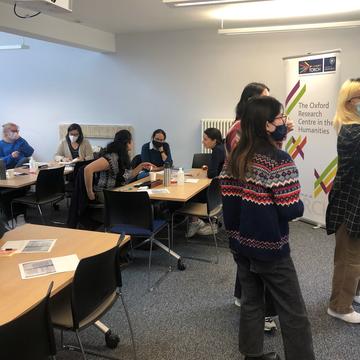Writing across cultures and evoking memories
As part of the fellowship project I led two writing workshops where we discussed and explored writing home in more personal, evocative ways, especially by making more connections with personal history, visuality and popular culture.I had a lot of fun planning these workshops too, and the planning process was both very inspiring and healing for me. Inspiring as it led me to thinking about the myriad connections between different individuals moving from one place to another, or changing from one home to another. Healing as it brought back more understanding and reckoning of our stories, and so made me less homesick than I was: having been unable to go home for three years since the start of the pandemic and the nearly one-month quarantine requirement literally making any holiday there quite unthinkable.
The first workshop was to explore the connection between memory and song. For me, the project was in part to share my own story of home. So I brought along some of my favourite classic and pop songs that I grew up with as writing prompts for the group. I have never used any Chinese pop songs as teaching materials before. But this project made me ask important questions about cultural memory, home and inclusivity. Why can I so shy to talk about the very things that matter in my personal history or identity, experiences that are are very much the fabric of everyday life? So I spent time choosing and translating the songs, giving the participants a glimpse into the sentiments of the people in the Chinese-speaking world. Together we listened to Teresa Teng’s melodic hit ‘The Moon Represents My Heart’ and Eason Chan’s ‘Shall We Talk’; compositions by Hong Kong musicians Jing Wong and composer Fung Lam, as I shared the lyrics in translation and explored the importance of making emotional connections through storytelling, which are very much a key element of these songs. Moreover, the music goes beyond what’s there in the lyrics. As a creative prompt, it makes us think or wonder about the context we appreciate or experience this song, think about the people whom we interact with. As a second part of our workshop, we had a wonderful virtual conversation with Oxford TORCH visiting fellow and musician Katie Melua, who delighted us by sharing her experience as a singer-songwriter, and how she created songs that tell an evocative story by the distillation of language and imagery.
And when we talk about storytelling and personal histories, how can we ever forget the importance of photography? Robert Frank—one of the most influential photographers of the 20th century--once wrote: ‘There is one thing a photograph must contain: the humanity of the moment.’[1] His book of photography, The Americans (1959) (based on a series of black-and-white photos he took during his cross-country trips in the US) has changed the way we perceive racial identities forever.[2] Photography is a way into other people’s lives, their loves, their triumphs and even their more vulnerable moments. The faces that you see in a photo: the pondering of the likelihood of those encounters or gatherings, or the familiarity of the faces. How do you reconstruct the fabric of personal history through contemplating an image, and how do you connect the visual with the factual? In the case of family photos, the feelings and memories you have for your family can be very complex and sometimes contradictory or difficult to articulate. So how do we revisit those moments in time, and capture them in words? How far can we translate an image into text: what do we do to dramatise an image? I love the result of our discussions: a white board filled with rich, different, bold ideas on how to capture or translate an image into literature, the necessity to interpret, and the ethics of looking. It was a heart-warming experience as participants brought and shared their family photos and photos of places that meant a lot to them, and discovered the value of these materials through sharing them with others. Above all, the remarkable poems and stories they produced in 15 minutes! We are excited about all these works and encourage everyone to submit their creative piece—be it poetry, stories, essays or photos and art—to be showcased digitally on TORCH’s digital library on home.
In Trinity term, we will be running our third in-person writing workshop – a personal history of objects on 6 June, so do join us and explore new ways of building narrative through engaging with real objects. Participants are welcome to bring along (small) objects from their own homes, so that we can discover new ways of looking at them and thinking about stories through discussions and activities. And for those who would like to have a look at some actual museum objects, we will take a short self-guided field trip to the Ashmolean Museum in the vicinity to get us thinking about colours, textures and annotations to do with cultural memories, places, and the documentation or interpretation of historical information. Through this group-led, collective research, we hope to help us discover new ways of seeing and more inclusive writing environments. I can’t wait to see what you’ll bring along!
[1]Philip Gefter, ‘Robert Frank Dies; Pivotal Documentary Photographer Was 94’, New York Times, (10 September 2019) <https://www.nytimes.com/2019/09/10/arts/robert-frank-dead-americans-photography.html> [Last accessed 5 April 2022]
[2] Ibid. See also Robert Frank, The Americans (Göttingen: Steidl Verlag 2008).



